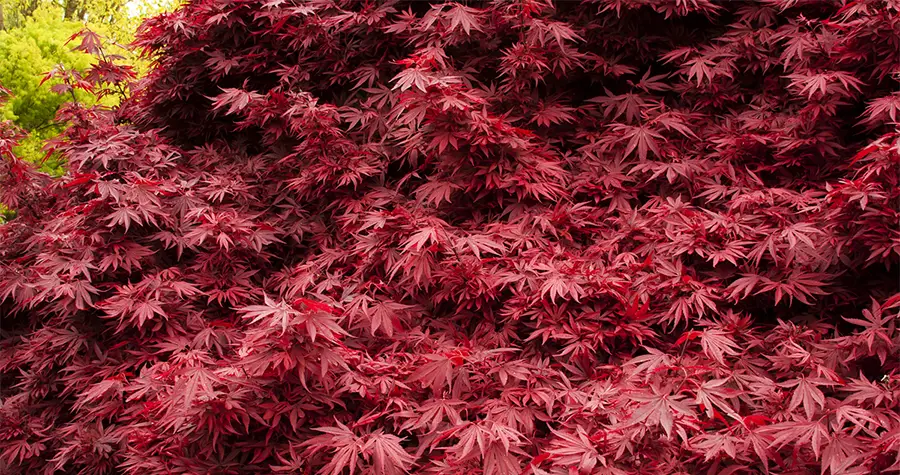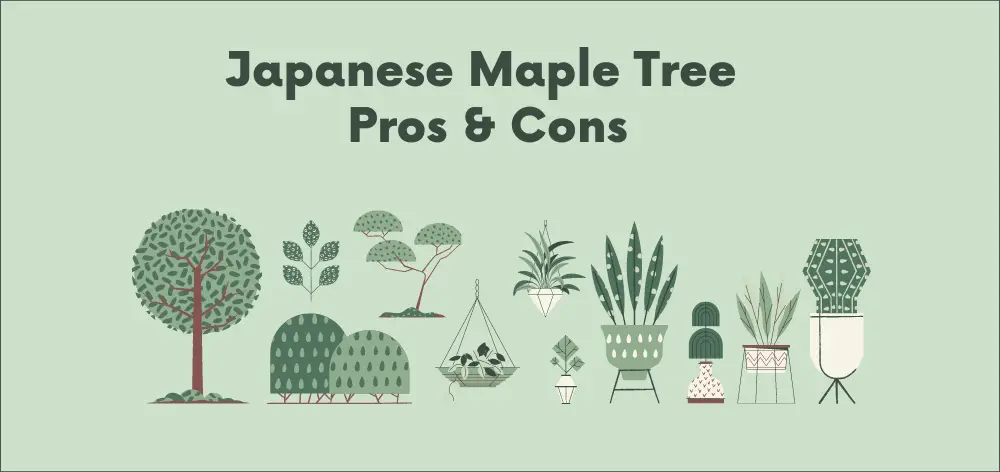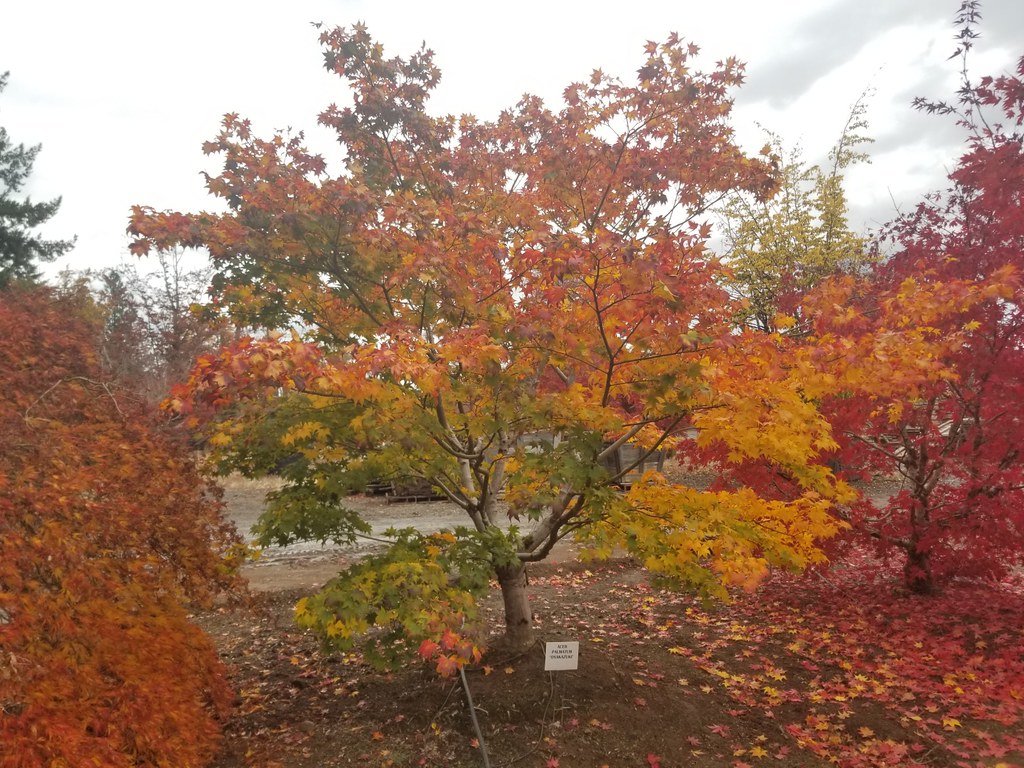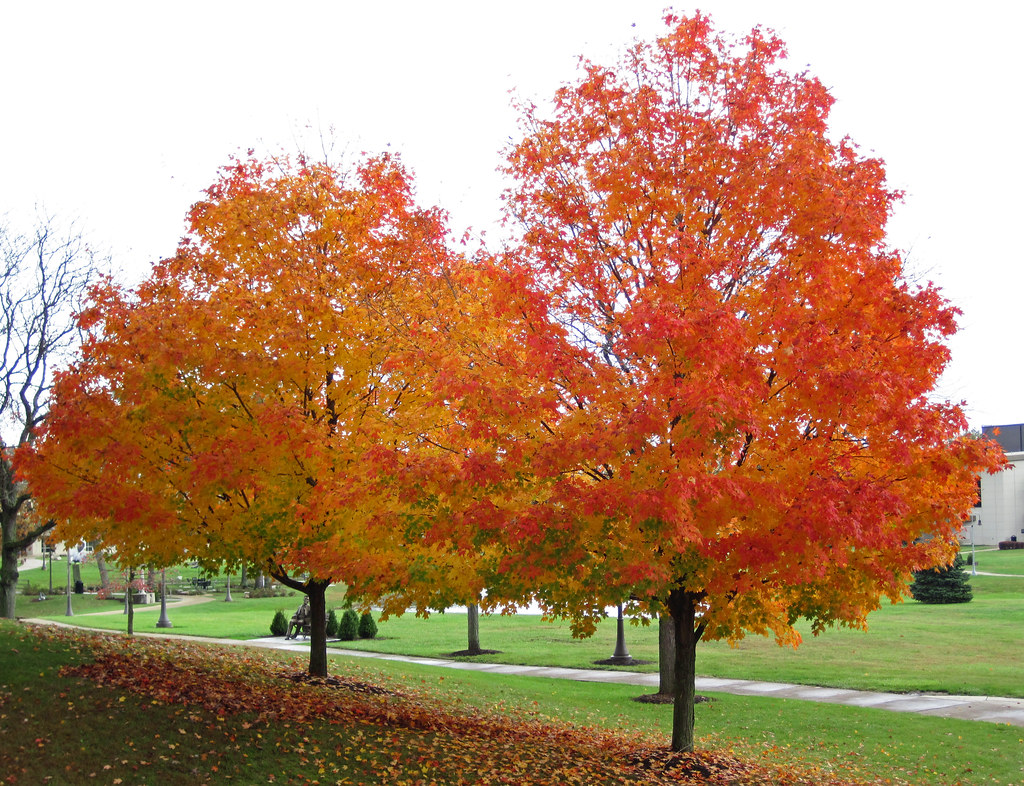Picture this: you’re strolling through a serene garden, the sunlight filtering through a canopy of vibrant foliage. The gentle rustling of leaves fills the air, and you find yourself captivated by the beauty of nature. Suddenly, your eyes lock onto a majestic tree that stands out among the rest – the Japanese Maple. Its delicate branches dance gracefully, adorned with leaves that boast an array of stunning colors.
The Japanese Maple tree, scientifically known as Acer palmatum, is a stunning and highly sought-after tree species that is native to Japan. Known for its delicate and vibrant, palate leaves, this tree has become a favorite among gardeners and landscapers around the world.
Today, we dive into the realm of Japanese Maple trees, weighing the pros and cons of inviting these arboreal wonders into your own backyard.
In this article, we’ll explore the enchanting world of Japanese Maples, those captivating trees that have stolen the hearts of gardeners and nature enthusiasts alike. Are you considering adding one to your landscape? Stick around, as we discuss the ups and downs of cultivating these gorgeous specimens. From their breathtaking aesthetics and unique features to the challenges they may present, we’ll cover it all. Whether you’re a seasoned gardener or just starting your horticultural journey, this article will help you make an informed decision about the Japanese Maple tree.
So, grab your gardening gloves and prepare to discover the pros and cons that come hand-in-branch with these mesmerizing trees. Let’s explore the captivating world of Japanese Maples together!
Factoids
- 🌳 Japanese maple trees are known for their distinctive leaves and branches, making them beautiful additions to gardens.
- 🌱 They are relatively easy to care for, requiring adequate water and protection from the sun.
- ⏳ Japanese maple trees have a slow growth rate and can live for many years, allowing you to enjoy their beauty for a long time.
- ❌ Disadvantages of maple trees include susceptibility to verticillium wilt, shallow root systems that can lead to toppling in high winds, and being prone to lightning strikes.
- 📍 Japanese maples prefer moist, well-drained soils and partial shade, and they are relatively tolerant of urban pollution.
- ✅ Japanese maple tree roots are shallow and non-invasive, making them suitable for small gardens and landscapes.
- 💰 Japanese maples can be pricey, with some varieties costing hundreds of dollars.
- 🚧 Their shallow roots require careful planting to avoid competing with other trees or causing damage to buildings or sidewalks.
Brandywine Maple Pros And Cons
If you’re considering planting a Brandywine Maple tree, there are a few things you should know. Here are the pros and cons of this type of maple tree:
PROS:
- The Brandywine Maple is a very hardy tree and can tolerate cold winters and hot summers.
- This type of maple has beautiful, deep red leaves that will add color to your landscape.
- Brandywine Maples are also relatively low maintenance and don’t require a lot of care.
CONS:
- One downside to the Brandywine Maple is that it has a slower growth rate than some other types of maple trees.
- It’s also important to note that the roots of this tree can be invasive, so make sure to plant it in an area where its roots won’t cause problems.
Sun Valley Maple Tree Pros And Cons
Are you considering planting a Sun Valley maple tree? Before you make your decision, it’s important to weigh the pros and cons of this type of tree. Sun Valley maple trees are known for their striking red leaves.
They’re also fast-growing, reaching up to 50 feet tall in just 20 years. And, they’re relatively low-maintenance, requiring little pruning or fertilizing once they’re established. On the downside, Sun Valley maples are susceptible to a few diseases and pests.
These include verticillium wilt, which can cause the tree to suddenly drop its leaves; aphids, which can distort new growth; and scale insects, which can suck the sap out of the leaves. Additionally, Sun Valley maples have shallow roots that can damage sidewalks and driveways if not properly managed. Overall, Sun Valley maple trees are a beautiful addition to any landscape.
Just be sure to do your research and be prepared to deal with some potential problems down the road.
Sugar Maple Tree Pros And Cons
Sugar maple trees are one of the most popular trees for landscaping in North America. They are known for their beautiful fall colors and their sweet sap, which is used to make maple syrup. But before you plant a sugar maple tree in your yard, it’s important to consider both the pros and cons.
Here are some of the main pros of sugar maple trees:
- They Are Beautiful Trees There’s no denying that sugar maples are beautiful trees. They have a classic symmetrical shape and their leaves turn a stunning shade of red, orange, and yellow in the fall. If you’re looking for a tree that will add curb appeal to your home, sugar maple is an excellent choice.
- They Provide Shade Sugar maples can grow to be quite large, so they make an excellent source of shade on hot summer days.
Autumn Blaze Maple Tree Pros And Cons
The Autumn Blaze Maple Tree is a hybrid of Red Maple and Silver Maple. It is known for its brilliant red fall color. The tree grows to a height of 40-60 feet with a spread of 30-50 feet.
The leaves are 3-5 inches long and have five lobes. The bark is reddish brown and the branches are stout. The Autumn Blaze Maple is fast growing, reaching maturity in 10-15 years.
It does best in full sun but can tolerate some shade. It prefers moist, well-drained soil but is tolerant of poor soils and drought conditions. The Autumn Blaze Maple makes an excellent shade tree or street tree due to its rapid growth rate and tolerance to urban conditions.
It is also widely used as a landscape specimen or accent tree because of its showy fall coloration. However, there are some drawbacks to this tree. First, it has brittle wood which can break easily in high winds or heavy snowstorms.
Second, the roots are shallow and widespread, making them susceptible to damage from lawnmowers or other yard equipment.
Japanese maple lifespan pros and cons
Japanese maple trees (Acer palmatum) have a long lifespan tree of about 50 to 100 years, depending on various factors such as care, climate, and species. Here are some pros and cons of Japanese maple trees:
Pros:
- Ornamental Beauty: Japanese maple trees are renowned for their stunning and unique foliage. They come in various colors, including red, green, and variegated, adding aesthetic appeal to landscapes and gardens.
- Versatility: There are numerous cultivars and varieties of Japanese maple trees available, offering a wide range of sizes, shapes, and growth habits. This makes it easier to find the right fit for different gardening preferences and spaces.
- Shade and Privacy: Japanese maples provide dappled shade, creating a cool and soothing environment. They can be strategically planted to offer privacy in your garden or yard.
- Low Maintenance: Once established, Japanese maples are relatively low maintenance, requiring minimal pruning and feeding. They are generally disease-resistant and less prone to pests.
Cons:
- Delicate Roots: Japanese maples have delicate and shallow root systems, making them susceptible to damage from foot traffic or heavy machinery. Care must be taken not to disturb the root area during construction or landscaping activities.
- Sun and Exposure: While Japanese maple trees thrive in well-drained soil with dappled shade, they may struggle in areas with intense sunlight or extreme heat. They may need protection from strong winds and scorching sun exposure.
- Size Limitations: Some Japanese maple varieties have limited growth potential, which may not provide substantial shade or be suitable for certain landscape designs. It’s important to consider the mature size of the tree when selecting a variety.
- Leaf Drop: Japanese maples are deciduous trees, meaning they shed their leaves annually. While this seasonal leaf drop can be considered a beautiful aspect, it requires regular cleanup and may not be desirable for those seeking evergreen trees.
Are Japanese Maple Tree Roots Invasive?
No, Japanese maple tree roots are not invasive. In fact, they are quite the opposite! Japanese maple tree roots are actually very shallow and non-invasive, making them ideal for use in small gardens and landscapes.
This means that they are less likely to cause damage to underground structures such as sidewalks, foundations, or pipes. However, it is always a good idea to provide sufficient space for the tree to grow when planting, and regular monitoring is recommended to ensure that roots do not cause any issues.
Are Japanese Maple Trees Good?
Japanese maple trees are good for a number of reasons. First, they are very beautiful, with their distinctive leaves and branches. Second, they are relatively easy to care for, as long as you give them enough water and protect them from the sun. Third, they are slow-growing and long-lived, so you can enjoy their beauty for many years to come.
What are the Disadvantages of Maple Trees?
There are a few disadvantages to maple trees. One is that they are susceptible to a disease called verticillium wilt, which can kill the tree. Another is that they tend to have shallow root systems, which can make them topple over in high winds. Additionally, maples are one of the most common types of trees to be struck by lightning.

Where is the Best Place to Plant a Japanese Maple?
There is no definitive answer to this question as it depends on a number of factors, including climate, soil type, and exposure to sunlight. In general, however, Japanese maples prefer moist, well-drained soils and partial shade. They are also relatively tolerant of urban pollution.
When choosing a location for your Japanese maple, be sure to avoid areas that are prone to flooding or extended periods of drought.
Frequently Asked Questions:
Where do Japanese maples grow best?
Japanese maples (Acer palmatum) grow best in regions with a temperate climate that provides the ideal conditions for their health and beauty. They are native to Japan and parts of nearby Asian countries. However, due to their popularity as ornamental trees, they are now grown in various regions around the world.
Is maple good for health?
Yes, maple is good for health. It contains antioxidants, vitamins, minerals, and natural sugars, making it a healthier alternative to processed sweeteners.
How long can a Japanese maple live?
Japanese maple trees (Acer palmatum) are known for their beauty and ornamental value. With proper care and a suitable environment, they can live for several decades and even reach a ripe old age. On average, a Japanese maple tree can live anywhere from 30 to 100 years or more.
Conclusion
Japanese Maple trees offer a range of benefits and considerations for landscaping enthusiasts. Their beautiful foliage adds year-round interest to gardens, and they are relatively low-maintenance, resistant to pests and diseases. However, it’s important to weigh the pros and cons before planting them. These trees prefer moist, well-drained soils and partial shade, and they are relatively tolerant of urban pollution. On the downside, Japanese Maple trees can be susceptible to verticillium wilt, have shallow root systems that may lead to toppling in high winds, and are prone to lightning strikes. Additionally, some varieties can be quite expensive. Despite these drawbacks, their slow growth rate and long lifespan allow for lasting enjoyment of their beauty. Overall, with proper care and consideration of specific factors such as climate and soil type, Japanese Maple trees can be a stunning addition to any outdoor space.
Relevant Articles
Tropical Forests’ Secret Weapon: Eco-Heroes of Carbon Storage
 Dr Ahsanur Rahman, PHD
Dr Ahsanur Rahman, PHD
How to Plant a Maple Tree Seed: A Step-by-Step Guide
 Dr Ahsanur Rahman, PHD
Dr Ahsanur Rahman, PHD








